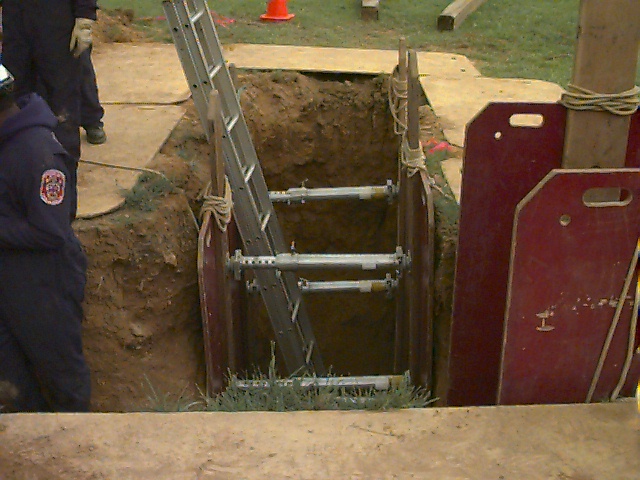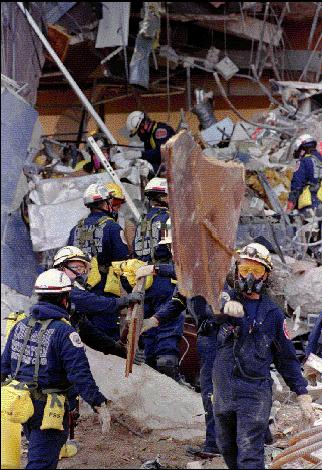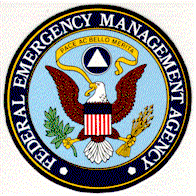Division of Operations

FEMA Urban Search & Rescue Task Force Maryland Task Force One

Maryland Task Force One Deployed To Pentagon
Montgomery County's Urban Search and Rescue Team, known as Maryland Task Force 1, has been deployed to the Pentagon in response to the terrorist attacks on September 11th. President Bush visited with the team members to express the his personal gratitude and thanks for their hard work.
The Urban Search and Rescue Task Force is a highly specialized group of fire fighters, paramedics, and civilian specialists who have trained to handle many difficult specialized rescue situations. The Team is one of four specialty teams of the Montgomery County Fire and Rescue Services of Montgomery County, Maryland. The majority of the Team's personnel serve as operational personnel in the Department. As a result of grant funding, the Team has been able to purchase unique rescue equipment to compliment their specialized training.
Montgomery County, Maryland and Regional Response

The Team maintains the Rescue Mall at the Montgomery County Public Service Training Academy. The Rescue Mall is a specialized urban search and rescue training facility that includes: a large classroom to seat approximately 60 students; a conference room; specialized props to simulate building collapses and confined spaces; vertical and horizontal concrete breaching stations; and "Da Spider", a series of masonry tubes arranged in a maze to simulate different confined space training evolutions. Additionally, the Rescue Mall is used for training search canines to locate victims in collapsed structures. The Rescue Mall is also used as the Team's Mobilization Center during National emergency responses.
In addition to specialized rescue responses, the Team has been involved in a number of major incidents that did not involve direct search and rescue intervention. The Team's Logistics Section was an integral asset in the Travillah Road Dump Fire, a long duration fire fighting operation. Members of the Team built shelters and provided other infra-structure support as well as provided supplies and equipment in order to support the fire fighting operations. In the winter of 1996, the Team provided strategic planning and logistical support during the Silver Spring Train Collision. In January 2000, the team responded and provided search and rescue operations to a major train accident in Alleghany, MD.
National Urban Search and Rescue Task Force
On a National basis, the Collapse Rescue Team responds as a FEMA Urban Search and Rescue Task Force to natural and man-made disasters as a part of the Federal Disaster Response Plan. The plan incorporates 12 emergency support functions (ESF) including Urban Search and Rescue (ESF-9). There are 28 Federally funded US&R Task Forces across the Continental United States. Each task force responds with 62 members filling 18 functional positions.

To fulfill part of the US&R Task Force responsibilities, the Team's equipment and personnel maintain a high state of readiness for US&R missions. The Team must be prepared to respond to their point of departure with 62 personnel and required equipment within six hours after an activation. To ensure that the Team minimizes an impact on disaster stricken local jurisdictions, the Team must be self-sufficient for the first 72 hours once they arrive at the disaster site. This includes: food, shelter, water, power, fuel, and supplies.
Training for the US&R Task Force missions have included "Operation Fairmont", a joint mobilization exercise with the Fairfax County US&R Task Force. "Operation BoO" was an exercise to establish a field Base of Operations. The Team often brings in nationally acclaimed experts to provide the latest information on disaster response. Additionally, the Team provides training to other organizations on disaster and prolonged incident response topics. The Team has hosted the FEMA Rescue Specialist, Canine Search Specialist, and Medical Specialist courses at the Collapse Rescue Team's Rescue Mall.
The Urban Search and Rescue Task Force has been activated for many incidents. The activations include:
- The Northridge Earthquake, Southern California (1994)
- Hurricane Marilyn, U.S. Virgin Islands (1995)
- The 1996 Summer Olympic Standby, Atlanta, Georgia
- Hurricane Fran, North Carolina (1996)
- Hurricane Floyd, North Carolina (1999)
- Oklahoma City Bombing in April (1995).
- Pentagon terrorist attack (2001
If you have any questions about the Urban Search and Rescue Team,
E-Mail: [email protected]
Updated November 26, 2007


